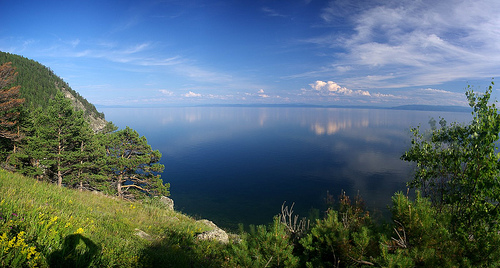Lake Baikal… the deepest of them all.
- Lake Baikal is a large, long and relatively narrow lake consisting of freshwater, located in Russia’s Siberia, in North Eastern Asia.
- ‘Lake Baikal’ is also known as the ‘Pearl of Siberia’ and the ‘Galapagos of Russia’, and in Russian it is ‘Ozero Baykal’ and ‘Baygal nuur’ in Mongolian, while the latter translates as ‘nature lake’.
- The UNESCO World Heritage Convention declared Lake Baikal a World Heritage Site in 1996, due to its rich ecosystem and its scientific significance.
- Lake Baikal contains the greatest amount of fresh water of all water bodies on earth, equalling around 20% of the total liquid fresh water in the world, and it is known for its water clarity, greatest depth of all lakes, and it holds the status of the seventh largest lake in the world.
- The volume of Lake Baikal is greater than 23,6oo cubic kilometres (5,600 cubed miles), it has an area of around 31,600 square kilometres (12,200 square miles) and a depth reaching more than 1630 metres (5,347 feet).
Lake Baikal
Image courtesy of Sergey Gabdurakhmannov/Flickr
- Lake Baikal is located in a rift valley surrounded by mountains, and sits above a divergent plate boundary where two plates are slowly moving away from each other, and this activity has created hot springs in and around the lake.
- Wildlife finds Lake Baikal a haven, with around 1,000 vegetation species and 2,500 animal species, including plankton, worms, snails, crustaceans, fish, and the Baikal seal, while large numbers of the species are endemic to the area.
- Humans had settled around Lake Baikal by 500 AD, primarily due to it being an accessible water source, and it became more widely known after 1643, when explorer Kurbat Ivanov from Russia found it.
- Lake Baikal freezes from January to May and can be crossed during these times, although it can be fatal, as the freezing winds can cause hypothermia and frostbite.
- Hundreds of rivers supply water to Lake Baikal, including the Sarma River, Selenga River, Snezhnaya River, Barguzin River and Turka River, while it drains into the ocean via the Angara River.
Bibliography:
Baikal – The Pearl of Siberia, 2005, Geographia, http://www.geographia.com/russia/baikal01.htm
Lake Baikal, 2015, Lake Baikal – World’s Deepest Lake, http://lakebaikal.org/
Lake Baikal, 2015, UNESCO World Heritage Convention, http://whc.unesco.org/en/list/754
Lake Baikal, 2015, Wikipedia, https://en.wikipedia.org/wiki/Lake_Baikal








